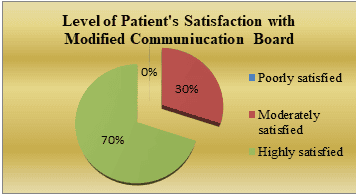A quasi-experimental study to assess the effect of modified communication board on communication ability of post-operative CABG patients at selected hospital Bhopal, Madhya Pradesh, India
Pakhide V.1*
DOI: https://doi.org/10.17511/ijmrr.2019.i06.06
1* Vandana Pakhide, Assistant Professor, Pragyan College of Nursing, Bhopal, Madhya Pradesh, India.
Inability to communicate can be a distressing problem for the patient who may be unable to speak because of the use of the paralyzing drugs or the endotracheal tube. The nursing management of the mechanically ventilated patient is challenging on many levels require acquisition of highly technical skills. Mechanically ventilated patient’s having more communication difficulties. Communicating effectively with ventilator-dependent patients is essential so that various basic physiological and psychological needs can be conveyed and decisions, wishes, and desires about the plan of care and end-of-life decision making can be expressed. Methods: The study subjects were 60 post operative CABG patients, 30 in each group; control group and experimental group selected through purposive sampling technique is often referred to as theoretical or judgmental sampling. Non equivalent control group design was used to assess the effectiveness of modified communication board on communication ability of post-operative CABG patients. Results: The obtained ‘t’ value is 12.15** is higher than the table value this indicates modified communication board is effective to enhance communication ability of post-operative CABG patients. Among experimental group about age and gender there was significant association found and in control group about gender association found, in clinical profile history of previous surgery strongly associated with communication ability of postoperative CABG patients. Conclusion: there was significant relation found between modified communication board and communication ability of post operative CABG patients. This type of studies helps the nurses working in intensive and critical care unit in communicating with the mechanically ventilated patients.
Keywords: Modified communication board, communication ability, CABG (Coronary Artery Bypass Graft)
| Corresponding Author | How to Cite this Article | To Browse |
|---|---|---|
| , Assistant Professor, Pragyan College of Nursing, Bhopal, Madhya Pradesh, India. Email: |
Pakhide V. A quasi-experimental study to assess the effect of modified communication board on communication ability of post-operative CABG patients at selected hospital Bhopal, Madhya Pradesh, India . Int J Med Res Rev. 2019;7(6):475-481. Available From https://ijmrr.medresearch.in/index.php/ijmrr/article/view/1097 |


 ©
© 